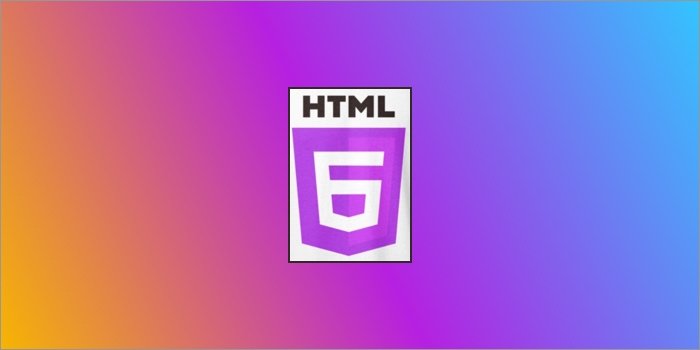HTML, the language of the web, is one of the most well-known web technologies. HTML has been used continually to build the internet since the dawn of the World Wide Web.

Although many new techniques have made the website creation process simpler and more efficient, HTML has always been there at the core.
HTML5 came out officially in 2014; it was one more step towards standardization of the hypertext markup language. The first version of HTML was written by Tim Berners-Lee in 1993. Since then, there have been many different versions of HTML. The most widely used version throughout the 2000’s was HTML 4.01, which became an official standard in December 1999. Another version, XHTML, was a rewrite of HTML as an XML language.
People now are waiting for another upgrade, and guess what? HTML6 is on its way.
What’s new:
- Express Tags
- Native Modals Support
- Freedom to Resize Image
- HTML 6 Dedicated Libraries
- Annotations for Images and Videos
- Authentication Enhancement
- Customized Menus in HTML6
- HTML6 Integrated Camera
- Good Microformats
- Single-Page Apps without JavaScript
- Conclusion
Express tags
As the name suggests, these tags are meant for fast use. These are tags such as <logo></logo> for the log on your pages, or something like <navigation></navigation>, <sidebar></sidebar>, etc. In addition to this, instead of having to write something like <div id=’container’>, you could just write <container>.
Native Modals Support in HTML 6
The <dialog> element is newwith HTML6. This element is considered equivalent to JavaScript-powered modal windows. Dialog elements are already standardized, but only a few browsers like Chrome and Samsung Internet browsers have full support. No worries, it would be working in all browsers soon.
This element, in its default format, would only show hover above the place it was placed. To use a more common modal-like interface, you can open the modal method through JavaScript.
<dialog>
<form method="dialog">
<input type="submit" value="Ok" />
<input type="submit" value="Cancel" />
</form>
</dialog>In its default form, the element creates a modal dialog box(black transparent background with non-interactive content below it). A method attribute can be used in the form inside the dialog element. This would submit the value and pass the value back to the dialog object itself. Overall, this dialog element is beneficial in a small interaction with the user and enhancing UI.
You can toggle the open attribute to open it and close it in the standard HTML form.
<dialog open>
<p>Dialog Box Built with HTML 6</p>
</dialog>Freedom to Resize Image
Experts believe that an update is on its way that would enable browsers to resize the image for the best viewing experience. Browsers face difficulties to show the best image size concerning device and window size. Src and IMG tags are not much powerful to handle this problem. A new tag <srcset> might be available. This tag could facilitate the browser to choose between more than one image to show the best viewing.
HTML 6 Dedicated Libraries
Introducing cachable libraries in HTML6 will be a step towards improving the productivity of both web designers and users.
Annotations for images and videos
It would be great if we could annotate images and videos in HTML. HTML5 provides us with the capability to interpret words, sentences, and paragraphs but not images and videos.
Many organizations in the field have offered solutions, and it looks like WHATWG would consider at least some of them.
Let’s hope; we will be annotating images and videos in the HTML soon.
Authentication enhancement
Although HTML5 is not bad in terms of security. Browsers and web technologies also provide reasonable protection. No doubt, there is much more that could be done in the domain of authentication and security.
Keys can be stored off-site; this would prevent access by unwanted people and bolster authentication. Using embedded keys instead of cookies, making digital signatures better, etc.
People and think tanks have a lot of solutions to offer, it’s all on WHATWG to accept or reject them.
Customized Menus in HTML6
The UI and OL tags are beneficial but do not fit well in every need. A tag or menu tag that could handle interactive elements better is the need of the hour.
The menu could handle list elements triggered by buttons inside the menu.
<menu type="toolbar">
<li><button>Cut</button></li>
<li><button>Copy</button></li>
<li><button>Paste</button></li>
</menu>The menu could enhance the capabilities of the list in HTML, and it could work well, even like a usual list.
HTML6 Integrated Camera
HTML6 would enable us to use the camera and media on our device for the best. We would be able to control the camera, its effects, modes, panoramic images, HDR, and other things.
We could use any media and repurpose it. There are a lot of things that could be made better with the camera and HTML6.
Good Microformats
A lot of times, we need to define our general information on the internet.
General information could be anything public like our phone number, name, address, etc. Microformats are the standards capable of defining general data.
Microformats can enhance a designer’s capabilities and can reduce the search engine’s efforts needed to deduce our public information.
Single-Page Apps without Javascript
linking anchor elements to JSON/XML, API endpoints, having the browser internally load the data into a new data structure [saves time]
Bobby Mozumder, Editor-in-Chief of FutureClaw Magazine
According to Mozumdert, this is the single-page app web design pattern that would improve responsiveness and loading times as there would be no need to load javascript… but this was available with HTML5
Conclusion
Nothing is perfect, even HTML. There are a lot of things that could be done with HTML specifications to make it better. Standardizing some useful norms should be done to enhance the powers of HTML. Small changes have already started rolling out. Considering what tech experts have to say and also listening to the general public could provide an idea. Enhancing Bluetooth support, p2p file transfer, malware protection, cloud storage integration, are some things that should be considered in the next version of HTML.
This is for the future. However, there are already some updates that have been introduced, and some are most likely to be announced soon, while others are mere predictions.
I hope this article helps you get an insight into HTML6. Thanks for reading and share it with other tech-geeks and HTML-nerds.



